 |
|

|
 |
TABLE of CONTENTS
 |
Legislature passes major transportation-related spending, policy bills |
By Joe Nietfeld, legislative liaison
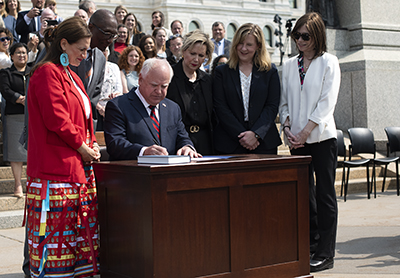
Gov. Tim Walz signs the Budget Bill during a ceremony May 26 on the Capitol steps. Photo by Rich Kemp |
When the Minnesota Legislature adjourned May 22, it marked the end of a busy session that included passing a $72 billion state budget. This included a major transportation omnibus bill with several new dedicated revenue sources and a $2.6 billion capital investment bill with $1.5 billion in borrowing and $1.1 billion in cash.
Transportation was a priority for the Legislature since the beginning of the session on Jan. 3. By Feb. 7, Chapter 6, authorizing MnDOT to spend $315.5 million of Infrastructure Investment and Jobs Act funding for state road construction work on the trunk highway system, was passed by the House and Senate and then signed into law. During this early period, committees also heard testimony from MnDOT staff on several issues, including the Governor’s transportation budget recommendations, transportation finance, federal infrastructure funding (specifically the IIJA and the Inflation Reduction Act), the National Electric Vehicle Infrastructure program, Buy Clean MN, Greenhouse Gas impact assessments, and living snow fences. Over the course of the session, prominent themes emerged in the work around transportation, with a focus on sustainability and the environment, safety, funding, and Corridors of Commerce.
Here are some highlights of the new spending and policy changes that affect MnDOT:
Transportation Omnibus Bill, Chapter 68
Budget changes
The bill makes significant investments in the state’s multimodal transportation system and includes several provisions for ongoing and sustainable funding for transportation. Once phased in, the new revenues increase dedicated state funding in the Highway User Tax Distribution Fund by approximately 20% over existing revenues (and about 27% for all modes combined) and include:
- Indexing the gas tax for inflation, capped at 3% increase in any year, with a projected increase of 5 cents by 2027
- Phasing in an auto parts sales tax to 2033, at which time 43.5% of the funds will go to the HUTD and 56.5% will go to a new Transportation Advancement Account
- Increasing tab fees
- Establishing a retail delivery fee of 50 cents per delivery for purchases of $100 or more, excluding food and most tax-exempt items
- Increasing the Twin Cities Metro sales tax by 0.75%, with 83% of revenue allocated to the Met Council for transit and 17% to Metro counties
- Increasing the motor vehicle sales tax from 6.5% to 6.875%
These revenue increases, along with additional general funds, ensure sufficient funds to provide state matches for federal spending from the IIJA across all modes. State revenues and general funds will complement this federal investment for crucial multimodal projects across Minnesota, including:
- $202 million (with a base of $50.5 million per year) in new state funding for state road construction
- $40 million in one-time funding for Greater Minnesota Transit, along with approximately $21 million per year in ongoing funding from additional motor vehicle sales tax revenue
- $36 million in one-time funding for state airports
- $13.6 million in one-time funding for electric vehicle infrastructure
- $2 million per year base funding to maximize IIJA climate funding
- $2 million of one-time funding for grant technical assistance to locals and tribal nations
- $216 million in one-time funding for IIJA discretionary grants match needs
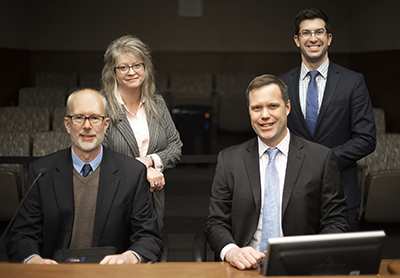
The MnDOT staff working with the Governor and the Legislature includes Erik Rudeen, Government Affairs Office director, Jennifer Witt, Legislative coordinator, Joe Nietfeld, Legislative liaison and John Dukich, Legislative Affairs manager. Photo by Rich Kemp |
New base funding in the Trunk Highway Fund is provided for operations and maintenance, program delivery, and agency services for ongoing needs and to help deliver and support the new IIJA funding. Also, base increases for 911 emergency, general and trunk highway fund operating appropriations will fund compensation cost increases including steps, cost of living and insurance, as well as rate and volume increases in IT services.
Several earmarks funded by the general fund or bonding were included in the bill. Highlights include $87.44 million for MnDOT facilities, $68.75 million for TH 65, $30 million for US Hwy 10, $194.7 million for the Northern Lights Express, $5 million for the Stone Arch Bridge, $50 million for Blue Line LRT, and $25 million for Rice Street redesign.
Policy changes
The bill includes several policy provisions for electric transmission lines in the right of way, weight limit exemptions, a new program for Safe Road Zones, Grade Crossing Safety Account, the State Rail Safety Inspection Program, traffic safety advisory council, a clean transportation standard fuel working group, active transportation, veterans with disabilities fee exemptions, Highways for Habitat, minimum crew size, rail safety, rail corridor service requirements, special permits for towing and forest products vehicles, IIJA discretionary match program and e-bike credits. Additional policy include:
- Changes to Corridors of Commerce, including a definition of regional balance and updates to the project solicitation, scoring and selection process
- For light rail transit projects, MnDOT will provide staff assistance for delivery method selection, risk assessment, contractor schedule analysis, project budget analysis and technical expertise
- Establish cost share for Greater Minnesota transit
- Mandate that MnDOT must participate in community engagement meetings and route alignment consultation in Minneapolis for the Blue Line LRT extension project
- Establish a task force to study Met Council governance
- Conduct an impact assessment for vehicle miles traveled and transportation greenhouse gas emissions
Except for technical changes to drone insurance requirements, all MnDOT’s policy provisions were included in the final bill. The Marketable Title Act was included in the omnibus judiciary bill.
Capital Investment Bills: Chapters 71 and 72
Early in the session, a $1.9 billion capital investment bill consisting of bonding and cash passed the House, but not the Senate. Negotiations resumed and on the final days of the session, a compromise was reached on a capital investment bill. House Files 669 and 670 contain a combined $2.6 billion capital investment funding of which $1.5 billion is GO bonds and $1.1 billion is cash. The bills allocate $402.641 million to transportation.
Lastly, several new task forces and working groups are required in the session law. MnDOT management will be reaching out to key staff to get these groups underway. Participation from MnDOT partners in industry, academia and consultants will be required for many of these task forces and working groups and for successful implementation of the session law in general.
For full details of the 2023 transportation-related session law, see the End of Session Summary or contact the Office of Government Affairs. |
| |
|

|
 |
TABLE of CONTENTS
 |
One of SW Minnesota's best anglers helped land the Hwy 23 Gaps project |
By Sandra Schlagel, D8 public engagement coordinator
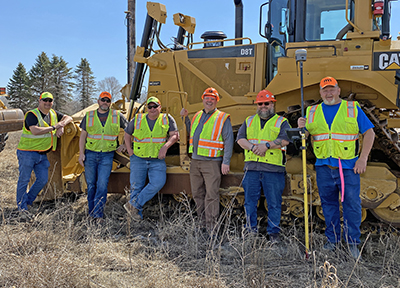
The Willmar construction crew during a Hwy 23 South Gap site visit prior to construction. Photo by Sandra Schlagel |
It’s hard to live in the Land of 10,000 Lakes and not hear your share of fish tales. So, it should come as no surprise that the Hwy 23 Gaps project begins with a fish tale, and like most fish stories, it’s a whopper.
The year was 2018, and the Highway 23 Coalition had been working diligently since the late 1990s to obtain funding for a four-lane expansion along the Hwy 23 corridor. Only two two-lane segments remained between Willmar and St. Cloud – New London to Paynesville and Paynesville to Richmond, known as “the gaps.” Unfortunately, Corridors of Commerce funding that year did not include the gaps expansion projects and the news was met with disappointment.
Then it was announced that the 2018 Governor’s Fishing Opener would be on Green Lake, along the Hwy 23 corridor, and the Coalition asked local fishing guide, Kelly Morrell, to advocate for additional bonding to include four-lane expansion for the gaps.
In Morrell’s boat on Opening Day, were Gov. Mark Dayton, House Speaker Kurt Daudt, House Minority Leader Melissa Hortman, Senate Majority Leader Paul Gazelka, and Gazelka’s son, Josh. They had a successful outing, and while heading back to the access, Morrell shut the motor down. He told the governor and legislators that he would be remiss if he didn’t share the recent tragic loss of an 11-year-old Hwy 23 crash victim, and how much it would mean not only to the safety of the community, but also the economy of the region to receive funding for the Highway 23 Gaps. Morrell pitched the idea of increasing the bonding proposal $101 million to include both gaps. The governor reportedly said he’d “take an earmark on 23” and he received support from everyone in the boat.
The governor’s boat caught eight fish, but the real catch of the day was the promise of funding for the Hwy 23 Gaps project.
Once Corridors of Commerce funding was approved by the Minnesota Legislature to include the Hwy 23 Gaps, District 8 went on to lead Program Delivery activities for both gap projects, known as the North Gap (Paynesville to Richmond) and the South Gap (New London to Paynesville). Construction for the North Gap began in 2022 and is being led by District 3. Construction for the South Gap began this spring and is being led by District 8.
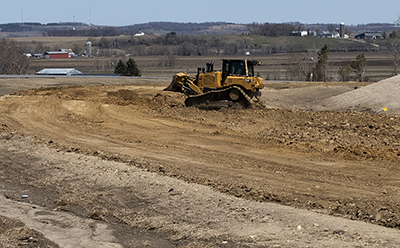
Crews are busy grading for the four-lane expansion on Hwy 23 near Paynesville. Photo by Rich Kemp |
The two-year South Gap project expands seven miles of Hwy 23 from two lanes to four. In spite of the never-ending winter which caused a three-week late start, the project is going as well as that fortuitous fishing opener.
“We are progressing ahead of schedule,” said Al Setrum, construction project supervisor. “The weather’s been good, grading has gone well, and most of the underground work is complete. Everything’s been in our favor so far.”
Both MnDOT and the contractor are using all the 3-D models provided to them by Design.
“It’s really made things efficient and has added to being ahead of schedule. We’re pushing the envelope digitally,” Setrum said.
As for challenges, he noted: “It’s not often you say this on a construction project, but they could use a little rain. With 95% of the grade being a cleaner grade of sand, they continually have to wet it down. They’re running three water trucks so a quarter inch or half inch of rain could help.”
Setrum said that the prime contractor, Mathiowetz Construction, has been great to work with and is managing the project very well on their end. With most of the four-lane roadway already built north of Hawick, if things continue to progress ahead of schedule, the project could see an early removal of the detour this year, or possibly early completion in 2024. But even if the project simply finishes right on time, every good angler knows that the big fish are worth the wait.
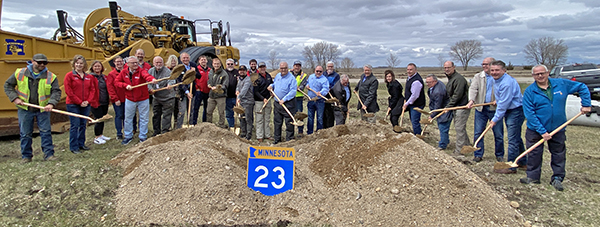
The Hwy 23 South Gap Groundbreaking was held April 28 with MnDOT Commissioner Nancy Daubenberger, District 8 Engineer Jon Huseby, District 3 Engineer Mike Ginnaty, elected state and local officials, Mathiowetz Construction, and community members. Photo by Sandra Schlagel |
|
| |
|

|
 |
TABLE of CONTENTS
 |
Metro District mourns loss of Roxy Bannerman |

Roxy Bannerman and her husband Jerry. Photo courtesy of the Bannerman family
|
Roxy Bannerman passed away June 30 after a brief illness. She was the executive administrative assistant for Mike Barnes, Metro District engineer, and the district leadership team.
Bannerman started with MnDOT in November 2021. Prior to MnDOT, she held many administrative positions including with Sperry Univac (Unisys), RGIS, Reader's Digest/Willow House, Marquette University and Eastern Virginia Medical School. She grew up in St. Paul and was thrilled to come back to Minnesota when she started with MnDOT.
“Roxy was a very caring person, great employee, friend to many and will be greatly missed,” said Barnes.
She loved to spend time with her husband Jerry, their dog Missy and all her grandchildren. She also loved to travel, scrapbook and cook.
In addition to her husband, Bannerman is survived by her son Dan (Marie) Salava; stepdaughter Liz (Tyler) Newkirk; stepson Matthew Bannerman; six grandchildren; and many nieces and nephews.
“The true definition of a tragedy,” said Scott Pedersen, Metro District Program Delivery director. “We all need to be thankful for the time we have and the relationships we make over time. Some only last for a brief period of time, but prove to be the most valuable.”
Funeral services were held for Bannerman July 8 in St. Paul. |
| |
|

|
 |
TABLE of CONTENTS
|
Lynn Clarkowski named Engineering Services Division assistant division director |

Lynn Clarkowski |
Lynn Clarkowski has been named the new permanent assistant division director in Engineering Services Division, after serving in the position in a work-out-of-class mobility role since September 2022.
Prior to taking on this position, Clarkowski served in several leadership roles in the Metro District, including as the operations and maintenance director and the program delivery director.
Clarkowski has also held positions managing MnDOT’s Office of Environmental Stewardship, along with other roles during her career in Metro District, Central Office and the private sector.
|
|

|
 |
TABLE of CONTENTS
 |
Agency artist in residence wraps up year of creative public engagement |
By Doug Mack
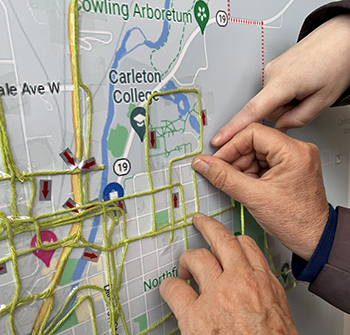
Participants at a "Tell Us How You Move Around" public workshop taped green yarn on the Northfield map to show where they like to go without driving. Photo by Sarah Petersen
|
After a year of public engagement and creative outreach, MnDOT artist-in-residence Sarah Petersen wrapped up her term with the agency at the end of May. The end of Petersen’s tenure also marks the end of MnDOT’s pilot period of the artist-in-residence program, which is formally known as the Transportation Equity Fellowship.
One of Petersen’s main initiatives was the Tell Us How You Move Around program, a series of workshops, graphics and other efforts to get people to, as she put it, “think of themselves as more than drivers” and to consider their many options for getting from place to place.
“It’s a way of encouraging people to think of themselves as multimodal transportation users already,” Petersen said, “and to articulate when and why they choose a different type of transportation beyond single-occupancy vehicles.”
Petersen took a multi-pronged approach to establishing, running and promoting Tell Us How You Move Around. One key element was creating a program website with surveys, forums, maps and other opportunities for members of the public to discuss their own experiences with transportation and suggestions for improving their experiences. Petersen also held a series of public workshops this spring, including in District 6, District 3 and Metro District, as well as MnDOT internal workshops. Far from being staid presentations, the events were highly participatory, with attendees making their own reflective accessories, creating collaborative community maps and playing what Petersen titled a “Move-Around Map Game.”
At the end of the workshops, Petersen asked participants for their feedback and takeaways.
“The insights that people would share really started to accumulate and show me where this conversation could be had,” Petersen said. “It also helped push people to advocate for their own transportation options.”
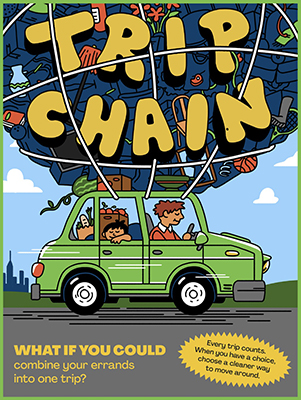
Illustrator Noah Lawrence-Holder worked with artist-in-residence Sarah Petersen to create a series of posters on the theme of multimodal transportation.
|
In addition to these direct, participatory efforts, Petersen worked with illustrator Noah Lawrence-Holder to create a visual campaign (titled “What if you could?”) to create inviting, public-facing imagery to promote multimodal transportation options. The full-color graphics can be used as posters, but Petersen and Lawrence-Holder also developed black-and-white versions that can be turned into coloring sheets and distributed at events or other public engagement efforts.
“I’m super excited that, through this umbrella project, I’ve been able to create something that’s useful and that can be used to generate a two-way conversation with people,” Petersen said, reflecting on the many aspects of her work during her term as artist-in-residence. “My whole goal was to create something where MnDOT could talk to people but also people could talk to MnDOT, and we would really listen to each other.”
“Sarah’s creative projects helped MnDOT understand individual transportation needs and desires around many different transportation options,” said Jessica Oh, strategic partnerships director in the Sustainability and Public Health Office. “She asked questions about the benefits and challenges of different choices and options. Her work has aided MnDOT discussing the many ways we can reduce single occupancy travel by promoting transit, biking, rolling and walking to achieve the state’s greenhouse gas reduction goals.”
More workshop photos found on this web page: https://talk.dot.state.mn.us/tell-us-how-you-move-around/news_feed/public-workshops-report-back-for-tell-us-how-you-move-around |
| |
|

|
 |
TABLE of CONTENTS
 |
Workforce Development offers insights on Leadership Development Program |
By Elizabeth Otto, Workforce Development
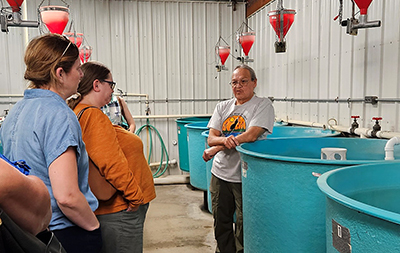
Leadership Development Program participants Jen Wiltgen, Metro District, and Kim Ellsworth, District 1/Duluth, (left) listen to an explanation of fishery practices from an employee of the Leech Lake Department of Resource Management (right). A tour of operations at the Leech Lake Department of Resource Management was included as part of a recent training about the work of MnDOTís Office of Tribal Affairs. Photo by Elizabeth Otto
|
The Leadership Development Program has been in existence at MnDOT for more than 10 years, offering employees from around the agency the opportunity to grow and thrive in their careers.
Enrollment for the next cohort of the LDP is open now and continues until July 28; the cohort will officially begin on Sept. 1. There are several ways to learn more about the LDP, including the program’s iHUB page and three upcoming informational sessions conducted via Teams (no registration required):
Workforce Development also put together the following list of myths and facts for anyone who might be interested in the program but has some questions.
MYTH: The Leadership Development Program is only for people who want to be managers or supervisors.
FACT: The Leadership Development Program is for all employees, including those who are not interested in becoming managers or supervisors. Enrolling in the Leadership Development Program will improve your effectiveness in your current role and give you the opportunity to develop and practice the skills that are the foundation of personal and career development.
MYTH: I’m already a manager or supervisor, so the Leadership Development Program is not for me.
FACT: If you are a manager or supervisor, enrolling in the Leadership Development Program is a great way to gain access to training and experiences that will improve your effectiveness as a leader and help you to meet your 16-hour annual training requirement.
MYTH: I’ve done LDP before so I can’t or don’t need to do it again.
FACT: You are welcome to enroll in the Leadership Development Program again with your supervisor’s approval. The training offerings of the Leadership Development Program change and expand every year. Enrolling in the Leadership Development Program again will allow you to work toward new goals or give you the opportunity to further expand your skill with competencies you worked on before.
MYTH: I don’t have time to do the work required to be in the Leadership Development Program.
FACT: The Leadership Development Program is self-directed, so you are the one who chooses the goals you want to accomplish and what work you will do to achieve those goals. As an LDP participant, you must attend a two-and-a-half-hour LDP Orientation and complete short online surveys to submit your goals and then report on your progress every few months during the 11-month program. You have both the freedom and responsibility to determine what other work you will do.
MYTH: The application process for LDP is hard and I don’t want to go through the hassle.
FACT: To enroll, complete the Commitment Agreement, which is available on the Leadership Development Program page on iHUB. This form requires you to enter basic information and select which required LDP Orientation session you will attend. Then, both you and your supervisor must sign the Commitment Agreement to indicate that you understand and agree to follow through on the requirements of the program. Email your completed and signed Commitment Agreement to the LDP Team during the open enrollment period, and you will be enrolled.
MYTH: If I enroll in the Leadership Development Program, I’ll have to take classes that don’t interest me.
FACT: You determine your goals for your time in the Leadership Development Program. Therefore, you decide what training and other activities you complete to achieve those goals. The one required training is the two-and-a-half-hour LDP Orientation you will complete just before your program year officially begins.
MYTH: If enrolling in LDP doesn’t guarantee me a promotion, there’s no point in doing it.
FACT: LDP participants report many benefits from their Leadership Development Program participation. In recent progress reports, participants have said:
- “I have used some of the skills learned to improve relationships with coworkers.”
- “I have worked with my team to better understand their needs and together we have set goals to cross-train everyone, so the unit is better prepared to complete their work.”
- “By learning more about MnDOT and how it operates it has been easier and faster to find help when needed.”
- “I have been able to delegate tasks to other co-workers and work effectively with them to get a task done.”
Email the LDP Team if you have any questions about the Leadership Development Program or the upcoming information sessions. |
| |
|

|
 |
TABLE of CONTENTS
 |
Microsoft Outlook automatic deletion is coming soon |
By Megan Bauer, Office of Chief Counsel
Properly deleting emails reduces financial liability and legal risk. A new standard will encourage MnDOT to use Outlook for its intended purpose as a communication tool, rather than as a file organization or storage system.
The MnDOT Technology and Data Leadership Committee recently approved a new email retention standard for all MnDOT employees and third parties with a MnDOT email account. When this standard goes into effect Jan. 29, 2024, MnDOT will automatically delete any Outlook items past their delete dates.
Delete dates are based on the location of each Outlook item. Any item past its delete date in Outlook will be permanently deleted. Contacts will not be affected.
- Messages and attachments stored in the inbox or additional folders created by MnDOT employees will be deleted two years after they were received. Sent items will be deleted two years after the date they were sent. Drafts will be deleted 30 days after they were first created. Anything in the deleted items or “trash” folder and junk/spam folders will be deleted 30 days after the date they entered these folders.
- Calendar items will be deleted four years after their final meeting date. For meetings across multiple days and recurring meetings, this is the last scheduled meeting date.
MnDOT employees have the option to move select emails to their Archive folder, where messages and attachments will be deleted 10 years after the receipt date on the email.
According to a survey conducted last spring, over two-thirds of MnDOT employees save email communication, content or attachments in Outlook more than one year. Only 40% of employees reported saving emails outside of Outlook.
“MnDOT has a statutory obligation to maintain the information it needs for the business we conduct,” said Josh Root, the agency’s deputy chief counsel, “but we also need to be transparent and are required to share our information with the public. By pairing back to the truly needed we will be a better partner while simultaneously reducing costs and risk.”
Employees have about six months to move emails and attachments with business value out of Outlook before automatic deletion goes into effect.
District 1 Engineer Duane Hill noted that the change “will have a big impact on some employees and no impact on others, depending on how they have chosen to manage their information.” Hill hopes that employees currently using Outlook as an information storage system will be able to adapt quickly.
Visit the Microsoft Outlook Automatic Deletion SharePoint for more information about the new standard and to access training resources for help with moving emails. |
| |
|

|
 |
TABLE of CONTENTS
 |
Seeds & Phoenix Day 2023 marks regrowth of career pathway programs for students |
By Michelle Clark, Office of Human Resources
Seeds and Phoenix student workers gathered with supervisors, managers and other MnDOT staff June 22 for the annual Seeds & Phoenix Day - a day for professional development, networking and celebration. It was the first time in four years the event occurred in person, and the energy in the room was contagious.
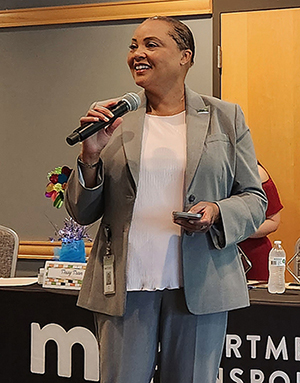
Deputy Commissioner Kim Collins spoke to the SEEDS and Phoenix students during the event. Photo by Michelle Clark
|
While the students spent the day learning about relationship building and working with different personality types, program staff celebrated the rebuilding of the programs.
The COVID-19 pandemic hit the Seeds and Phoenix programs hard. Program participation marked historically low numbers due to the State of Minnesota’s limited hiring freeze and students moving to remote learning. Over the last two years, the programs began to rebound, and for the first time since 2019, three Phoenix students transferred into the Seeds program – re-establishing the talent pipeline between the programs.
During Seeds & Phoenix Day, Deputy Commissioner Kim Collins shared with the students the important role they have at MnDOT. She spoke about the fresh perspective the students bring to their MnDOT roles and how it carries into the innovation and evolution of the agency.
The Seeds and Phoenix programs can create a pathway into a future career at MnDOT while allowing students to develop their professional skills. Building a Spectrum of Colorful Relationships was the theme for Seeds & Phoenix Day, and students received plenty of tools and time to develop those skills throughout the day.
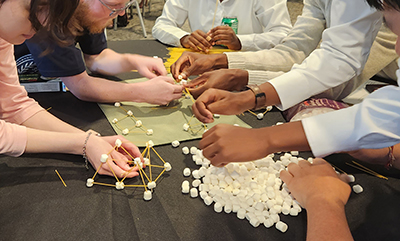
The students used spaghetti noodles and mini marshmallows to build bridges. Photo by Michelle Clark
|
Early in the morning, keynote speaker Carole Burton took the students on a journey of new ways to approach relationship building and networking that feel more natural and less stressful. After Burton’s information-packed presentation, the students put their new relationship-building skills into action as they worked in small groups to build a weight-supporting bridge using spaghetti noodles and mini marshmallows. The activity was a sticky success.
The event wrapped up with Trish Signor, training and development specialist, taking the students through the Real Colors workshop. Throughout the afternoon, the students discovered their personality-type colors and how the colors interact and work best with each other.
The energy and excitement of the day are true signs of the Seeds and Phoenix programs' regrowth over the last two years. As the programs continue to build, so will the future of MnDOT. |
| |
|

|
 |
TABLE of CONTENTS
|
On the job: Sarina Men's MnDOT career comes full circle as assistant active transportation safety engineer |
By Rich Kemp
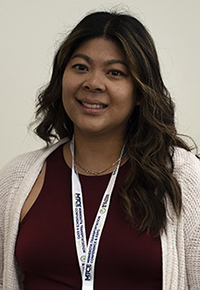
Sarina Men |
Sarina Men has been full-time at MnDOT since January 2020. She works as the Assistant Active Transportation Safety Engineer.
What has been your career path at MnDOT?
I interned with MnDOT in the summer 2019 in the Office of Traffic Engineering – Traffic Safety. In January 2020, I came back to MnDOT and joined the Graduate Engineer Trainee Program. During the two-year program I did rotations in District 1 Traffic, Metro Design, Construction, Government Affairs, Regional Transportation Management Center, North Area Management and Metro Traffic.
After my rotations, I was placed in Metro Signing as the West Area Signing Engineer. I worked on signing plans for projects in Hennepin and Carver counties, as well as responded to public complaints and signing requests as needed.
In September 2022 I started my current position as the Assistant Active Transportation Engineer. I essentially went full circle from where I started as an intern.
What do you do in your job?
The main part of my job is providing active transportation scoping recommendation reports for future MnDOT projects. This includes coordination with our consultants and the districts to select and review future projects to scope. When I am not doing scoping work, I am working on various projects or studies regarding traffic safety.
What is a typical day like?
A typical day consists of meetings about the projects I am working on, finalizing the Minnesota Horse and Buggy Manual, helping my teammate with an evaluation, or going on field walks and reviews.
What is your favorite part about your job?
I love being able to work on a lot of different projects around the state, as well as getting to know people at the different districts. A highlight of my job so far has been writing the Minnesota Horse and Buggy Manual.
What are the biggest challenges?
The biggest challenge has been switching from vehicle centric mindset to multimodal/active transportation mindset, and convincing others that people do exist on our roadways, and we should build for them.
What kind of changes have you seen in your job?
The biggest challenge is being able to juggle multiple projects and tasks that are very different from each other.
What are your interests or hobbies outside your work with MnDOT?
Outside of work I like to travel, go to concerts and crochet.
Do you or a co-worker have an interesting job to share with readers? Send us your ideas, and we’ll contact you for more information.
Recent employee profiles:
|
 |
|

|
 |
TABLE of CONTENTS
|
RTMC marks 20 years in Roseville |
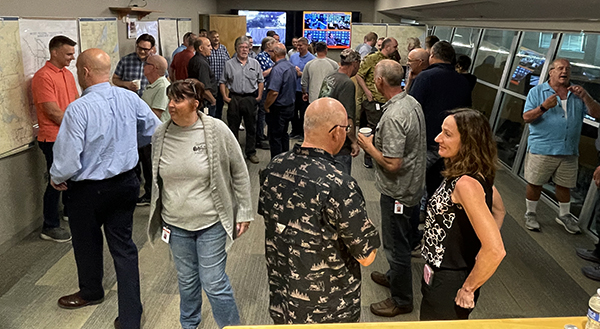
The Regional Transportation Management Center hosted an open house June 21 marking 20 years at its current site next to the Waters Edge building in Roseville. Previously known as the Traffic Management Center, the center was located at the south end of downtown Minneapolis before operations moved in April 2003. Video displays at the event included old clips of traffic flowing through the Twin Cities through the last 15 years and displays in the hallway described some of the technical changes in traffic management technology throughout the years. Several MnDOT and Minnesota State Patrol vehicles were on display outside. Photo by Joseph Palmersheim |
|
 |
|

|
 |
TABLE of CONTENTS
|
Deputy Commissioner Kim Collins receives Women Who Move award |
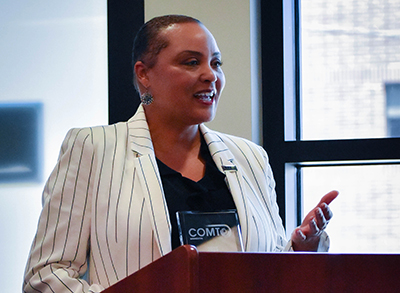
Deputy Commissioner Kim Collins received a Women Who Move award from the Minnesota Chapter of the Conference of Minority Transportation Officials at a ceremony June 13.
The award honors women who have made a positive impact on the transportation industry in Minnesota. Photo by Michelle Clark |
|
 |
|

|
 |
TABLE of CONTENTS
|
MNIT honors Beth Guidarelli as Manager of the Year |
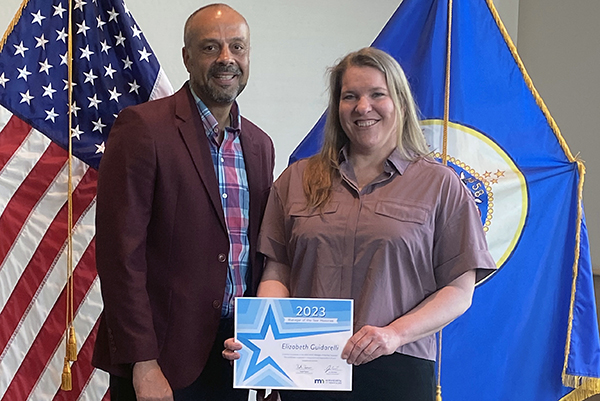
MNIT Application and Data Development Manager Beth Guidarelli, who is embedded in the MnDOT Office of Financial Management, was named Manager of the Year at the MNIT Annual Awards June 23. The awards program honors excellence and exemplary performance in advancing MNIT's mission, vision and guiding principles. Photo courtesy of MNIT |
|
 |
|

|
 |
TABLE of CONTENTS
|
Traffic Cam Puzzler #4 |
By Doug Mack
Can you name the place pictured below? The photo is from a traffic camera on the 511 website and app and the satellite view shows its location with the road labels removed.
If you think you know the answer, email the Newsline team. The first three people to submit the correct answer will receive the fame and glory of having their names listed in the next issue of Newsline.
Results from the last Puzzler: The location on Hwy 75 and Hwy 10 at 8th Street in Moorhead. More than 40 people submitted answers and nearly all of them were correct. The first three to get it right were Anna Pierce (Central Office), Karen Scheffing (Central Office) and Chris Moates (Central Office). Congrats to them and thanks to everyone who played! And special thanks to Lia Nistler (District 3) for sharing the fun fact that the Dairy Queen pictured in the background is a historic spot where the Dilly Bar was invented.
|
 |
|
|
|



